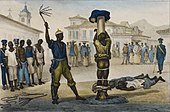Knout
| Part of a series on |
| Corporal punishment |
|---|
 |
| By place |
| By implementation |
| By country |
| Court cases |
| Politics |
| Campaigns against corporal punishment |
A knout /ˈnaʊt/ (Russian: кнут, Russian pronunciation: [knut]) is a Russian whip that consists of a rawhide thong or a rope attached to a long wooden handle. Commonly used for prodding horses or cattle, knouts were also used for flagellation as a corporal punishment in Russian history. The English word is a spelling-pronunciation of a French transliteration of the Russian word кнут (knut), which means "whip".
Etymology

The word may be derived from the Swedish knutpiska, a kind of whip with knots. The stem knut is of generic Germanic origin; compare with the German Knute, Dutch knoet (both meaning knout) and with Old Norse knutr, Anglo-Saxon cnotta and English knot.[citation needed]
For corporal punishment
According to Brockhaus and Efron, a typical knout used by Russian executioners consisted of a wooden handle about half arshin (35 cm (14 in)) to which attached was a thick braided rawhide piece, one arshin (70 cm (28 in)) long. The latter piece ended in a metal ring, to which was attached a wide rawhide belt made as long, also of one arshin length with a stiffened beak-like end.[1]


Knouts were used in Russia for flogging as formal corporal punishment of criminals and political offenders. The victim was tied to a post or on a triangle of wood and stripped, receiving the specified number of strokes on the back. A sentence of 100 or 120 lashes was equivalent to a death sentence.[citation needed]
Emperor Nicholas I abolished punishment by knout in 1845, after years of deliberation, and replaced it with the pleti,[1] a lighter whip, commonly with three tails, which was used previously for punishment as well.[2]
See also
References
- ^ a b . Brockhaus and Efron Encyclopedic Dictionary (in Russian). 1906.
- ^ . Brockhaus and Efron Encyclopedic Dictionary (in Russian). 1906.
- This article incorporates text from a publication now in the public domain: Chisholm, Hugh, ed. (1911). "Knout". Encyclopædia Britannica (11th ed.). Cambridge University Press.
External links
 The dictionary definition of knout at Wiktionary
The dictionary definition of knout at Wiktionary
